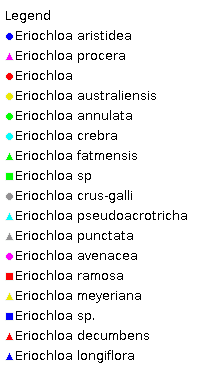Eriochloa Nova Gen. Sp.1: 94 (1816).
Derivation:. From Greek erion (wool) and chloe (grass) as the first species described had hairy glumes.
Key references (keys and floras):. G.Bentham, Flora Australiensis 7: 462–463 (1878); C.A.Gardner, Flora of Western Australia 1 Gramineae 231–233 (1952); J.W.Vickery, Flora of New South Wales, Gramineae 19: 76–81 (1961); E.E.Henty, Manual Grasses New Guinea 101 (1969); M.Lazarides, Tropical Grasses S.E. Asia 121 (1980); M.Lazarides, Flora of Central Australia 477–478 (1981); J.C.Tothill and J.B.Hacker, Grasses of Southern Queensland 240–242 (1983); J.P.Jessop, Flora of South Australia 4: 1966–1967 (1986); R.D.Webster, Australian Paniceae 89–94 (1987); T.D.Macfarlane, Flora of the Kimberley Region 1173–1174 (1992); B.K.Simon, Key to Australian Grasses 120 (1993); S.W.L.Jacobs and C.A.Wall, Flora of New South Wales 4: 453–455 (1993); N.G.Walsh, Flora of Victoria 2: 595 (1994); D.Sharp and B.K.Simon, AusGrass (2002); J.P.Jessop, Grasses of South Australia 450–454 (2006).
W.D.Clayton & S.A.Renvoize, Genera Graminum (1986), genus (488).
Native and naturalised. 30 species, from subtropical regions. 7 species in Australia, NT, SA, Qld, NSW, and Vic. Also New Guinea and Malesia.
Habit. Annual or perennial, stoloniferous or tufted to decumbent. Leaf blades narrow. Ligule a fringed membrane (very reduced) or a fringe of hairs.
Inflorescence. Inflorescence of spicate main branches or paniculate (usually of simple or compound racemes, very rarely a single raceme (E. distachya) or a contracted panicle (E. meyeriana)), a racemose panicle with spikelets all similar, open.
Spikelets. Spikelets dorsally compressed, 2 flowered, with 1 fertile floret, awned, solitary or paired (or in clusters). Fertile spikelets with lower incomplete floret(s), elliptic or lanceolate or ovate, adaxial (with lower glume against rachis) (nearly always with a small basal swelling representing fusion of the usually vestigial lower glume to the swollen internode), falling with glumes.
Glumes. Glumes unequal (nearly always) or more or less equal, (the upper) long relative to adjacent lemmas, pointed (upper glume pointed to aristulate), awned (upper glume, when aristulate) or awnless, non-keeled, dissimilar (the lower nearly always reduced to a small cupuliform strip adherent to the thickened rachilla internode). Upper glume 5 nerved.
Florets. Lower incomplete floret(s) male, or sterile. Lemmas awnless, 5 nerved (similar to the upper glume, or shorter), exceeding fertile lemmas, less firm than fertile lemmas (membranous), not becoming indurated. Fertile florets 1. Lemmas decidedly firmer than glumes, rugose, becoming indurated to not becoming indurated (papery to crustaceous), yellow in fruit, entire at apex, mucronate to awned, with a clear germination flap, 5 nerved, glabrous (glabrous or apically puberulous), having margins tucked into palea. Awns apical, non-geniculate, much shorter than body of lemma. Palea relatively long, entire (rounded apically), textured like lemma, 2 nerved. Lodicules 2. Stamens 3. Grain small, compressed dorsiventrally. Hilum short. Embryo large.
Kranz Anatomy. C4, biochemical type PCK (5 species).
2n = 36, 54, and 72, 4, 6, and 8 ploid, commonly adventive.
Habitat. Helophytic to mesophytic. Damp ground and weedy places. Species of open habitats.
Classification. Panicoideae; Paniceae.
Notes. A uniform genus of indistinctly separated species. It is distinguishable by a little bead at the base of each spikelet. This is formed from the lower rhachilla internode which becomes swollen and fused to the lower glume (Clayton and Renvoize, 1986).
Types Species. E. distachya Kunth.
Biogeographic Element. Clifford & Simon 1981, Simon & Jacobs 1990: Gondwanan.


